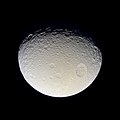Fasciculus:Tethys cassini.jpg

Mensura huius perspectionis: 600 × 600 elementa imaginalia. Aliae mensurae: 240 × 240 elementa imaginalia | 480 × 480 elementa imaginalia | 1 000 × 1 000 elementa imaginalia.
Sua resolutio (1 000 × 1 000 elementa imaginalia, magnitudo fasciculi: 368 chiliocteti, typus MIME: image/jpeg)
Historia fasciculi
Presso die vel tempore fasciculum videbis, sicut tunc temporis apparuit.
| Dies/Tempus | Minutio | Dimensiones | Usor | Sententia | |
|---|---|---|---|---|---|
| recentissima | 18:17, 12 Decembris 2018 |  | 1 000 × 1 000 (368 chiliocteti) | Kesäperuna | 100% JPEG quality from full quality TIFF. |
| 08:19, 6 Maii 2015 |  | 1 000 × 1 000 (68 chiliocteti) | Jcpag2012 | Reverted to version as of 05:22, 31 January 2005 | |
| 09:12, 20 Martii 2015 |  | 746 × 680 (60 chiliocteti) | Jcpag2012 | Cropped 25 % horizontally and 32 % vertically using CropTool with lossless mode. | |
| 05:22, 31 Ianuarii 2005 |  | 1 000 × 1 000 (68 chiliocteti) | Bricktop | ||
| 13:31, 29 Novembris 2004 |  | 600 × 538 (47 chiliocteti) | Wricardoh~commonswiki | Thethys (satellite of Saturn) imaged by the Cassini spacecraft. |
Nexus ad fasciculum
Ad hunc fasciculum nectunt:
Usus fasciculi per inceptus Vicimediorum
Quae incepta Vici fasciculo utuntur:
- Usus in af.wikipedia.org
- Usus in ast.wikipedia.org
- Usus in be.wikipedia.org
- Usus in bg.wikipedia.org
- Usus in bn.wikibooks.org
- Usus in bs.wikipedia.org
- Usus in cs.wikipedia.org
- Usus in da.wikipedia.org
- Usus in de.wikipedia.org
- Usus in de.wikibooks.org
- Usus in el.wikipedia.org
- Usus in en.wikipedia.org
- Usus in en.wikibooks.org
- Usus in en.wikisource.org
- Usus in eo.wikipedia.org
- Usus in es.wikipedia.org
- Usus in fi.wikipedia.org
- Usus in fr.wikipedia.org
- Usus in gn.wikipedia.org
- Usus in hr.wikipedia.org
- Usus in hy.wikipedia.org
- Usus in it.wikipedia.org
- Usus in ja.wikipedia.org
- Usus in ja.wikibooks.org
- Usus in ka.wikipedia.org
- Usus in ko.wikipedia.org
- Usus in lt.wikipedia.org
- Usus in lv.wikipedia.org
- Usus in ml.wikipedia.org
- Usus in ms.wikipedia.org
- Usus in mwl.wikipedia.org
- Usus in nl.wikipedia.org
- Usus in nn.wikipedia.org
- Usus in no.wikipedia.org
- Usus in pl.wikipedia.org
View more global usage of this file.

